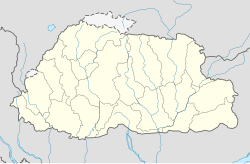| Choedrak Monastery | |
|---|---|
| Religion | |
| Affiliation | Tibetan Buddhism |
| Location | |
| Location | Bumthang District |
| Country | Bhutan |
| Geographic coordinates | 27°32′N90°41′E / 27.53°N 90.69°E |
| Architecture | |
| Founder | Lorepa |
| Date established | 1234 |
Choedrak Monastery is a Buddhist monastery in Bhutan, located at an altitude of 3,800 metres, not far from Tharpaling Monastery in Bumthang District. Guru Rinpoche is said to have meditated at this spot. [1]
Contents
It is 37 kilometers from Chamkhar and takes one hour to reach from the motorable road end at Tharpaling monastery. Choedrak Goenpa can also be reached after three-hour hike from Lamey Goenpa in Choekhor Valley. [2] It is one of the four sacred cliffs of Guru Rinpoche in Bumthang. The other three are Kunzangdrak, Shukdrak and Thowadrak. [3]
